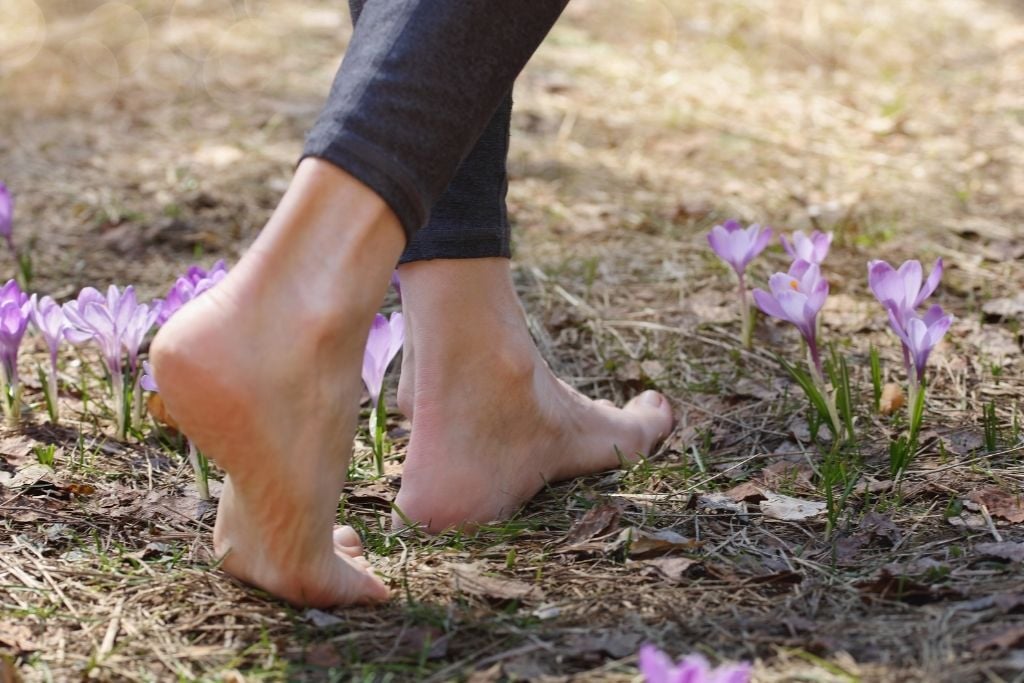
Mental health is a growing concern in this generation. And most people experience mental setbacks from time to time. But the severity of the experience can vary. It can come in the form of anxiety, panic attacks, depression, flashbacks, dissociation, and so on. Further, getting rid of the problems from their roots may need more work and professional help. But there are ways to bring yourself out of these negative experiences. Grounding is one such method of working towards your emotional well-being. There are many grounding techniques that can help you distract yourself.
Before exploring the different grounding techniques, let’s identify ungrounded behavior.
Are You Ungrounded?
SUMMARY
Ungroundedness is a state of being where a person mentally drifts away from the present.
Ungrounded people are often the victims of anxious thoughts. Which makes their mental state aloof and distant from the present moment. They relive old events in their mind or worry about the future. This leads them to feel anxiety, depression and other negative emotions.
Ungrounded people may have some of the following qualities –
- You get distracted with ease.
- You find it hard to focus on a task.
- You zone out from time to time.
- You get involved in personal drama.
- You are anxious more often than not.
- You worry all the time.
- You overthink stuff.
- Your personal image means everything to you.
- You have difficulty sleeping.
- You have inflammation.
- You feel tired all the time.
- You experience chronic pains.
Being ungrounded is one of the top reasons for human suffering. As a result, most people in the world are prey to this. So it’s a question of whether they realize it or not. Many people realize it only when the problems they face are severe. And when they are in need of immediate attention.
What is Grounding?
SUMMARY
Being completely grounded is actually the ideal way for a human being to live. Grounded people are “here and now”. Therefore, they concentrate on reality and tackle situations as they come.
Grounding is a method that allows you to stay in the present moment. Firstly, it persuades you to stop living inside the stories your mind creates and return to the real world. Secondly, it stops you from reliving disturbing and challenging emotions. Consequently, grounding techniques work to help you refocus on the present. And thus center your body and mind.
NOTE
Most ungrounded experiences that cause people pain stem from past events. But they relive these events in their minds over and over. The brain perceives these intense events as something happening in the present moment. As a result, this causes a person’s body and mind to experience the negative emotions again.
Certain emotional episodes can be overwhelming for some people. So, regaining your mental focus is important when you experience such intense emotions. Various grounding techniques can help you to cope with these difficult times on your own.

Top 9 Grounding Techniques for Anxiety
Here are some grounding techniques that can help you reorient yourself to reality.
1. Take deep breaths

Breathwork is one of the most efficient grounding techniques. Firstly, it’s easy. Secondly, it needs no equipment. And finally, you can do it anywhere anytime.
There are two widespread methods used by people around the world –
- Belly Breathing – To practice this grounding exercise, keep one hand on your belly and the other on your chest. Breathe in slowly and feel your belly rise up like a balloon. Then breathe out completely while still focusing on how your belly is deflating. Do this for a few minutes till you feel a sense of calmness engulf you.
- 4-7-8 Breathing – To adapt this breathing technique, inhale slowly and deeply. Count till 4 in your head. Then hold your breath as you count till 7. Follow it up by exhaling as you count till 8. Repeat this cycle until you feel better. Moreover, you can adjust the numbers according to your lung capacity.
2. Observe your surroundings

Observation is a great way to stay present. So, look at whatever is around you and find something to pay attention towards. Here are some ideas –
- Observe the people around you – What are they wearing? Which color are their clothes? How is their hair done? What is their body language?
- Notice the different types of trees/plants around you – What is the size of the tree? How many branches does it have? Are there any hanging fruits? What is the shape of the leaves? Are there flowers on the plant?
- Recognize the colors around you – Can you spot all the colors from the rainbow around you? Which is the brightest color you can find? How many colors can you name in total?
- Pick up objects from your surroundings and observe how they feel – Take account of the objects around you. Pick something up like a smooth stone. Run your fingers through the surfaces and edges of the object and feel the sensation. Is it sharp? Is it flat? Is it round? Is it cold? Is it warm? Is it light? Is it heavy?
3. 54321 Grounding technique

This technique plays on a similar concept as the previous point. But it’s more structured and can help you if you’re feeling anxious, wherever you are.
Before exercising the 54321 grounding technique, first bring your awareness to your breath. Is it slow, fast, deep? This will help you become calmer and feel more collected.
Next follow these steps –
-
5 – Look around you and be aware of five things you can see with your eyes.
It could be the painting on your wall, your rocking chair, a crack on the ceiling and so on. -
4 – Recognize four things around you that you can touch with your hands.
It could be your blanket, the fruit on the table, or the book next to you. -
3 – Next up, acknowledge three things you can hear from your ears.
It could be the birds chirping outside or the clock ticking away. -
2 – Now recognize two things that you can smell with your nose.
It could be the perfumed coat hanging in your wardrobe or the smell of a plant. If you can’t smell anything from where you sit, take a short walk around the house to find some smell. - 1 – Finally be aware of one thing you can taste with your tongue. It could be the lingering taste of coffee or sour candies inside your mouth!
4. Meditate with focus

If you are familiar with meditation, it can be a good grounding practice. If not, then close your eyes and take a couple of deep breaths. First, relax your shoulders and observe how you feel. Then shift your focus to different parts of your body as you continue deep breathing.
Now focus on how this makes your body feel. Subsequently, shift your focus to parts of your body that feel tense. Continue closing your eyes and breathing until you start feeling calm.
5. Grounding Exercises

Exercise is a great way to become present as they produce endorphins. From wiggling your toes to stretching your limbs, moving your body is very helpful. However, pay attention to the different sensations while exercising different parts of your body.
You can also try jumping jacks, skipping, brisk walking and running. Yoga is another great physical exercise you can do when you feel anxious. Conduct the asanas focusing on your breath and every move. Pick the activity that feels good.
6. Connect with nature

Getting outdoors can make a huge difference in your mood. Especially when you spend more time indoors. So walk out of the house, or take a stroll around the block. Further, take in the sights of the big trees, small plants, little animals and chirpy birds.
Observe the sounds you hear and the fragrances you smell. Connecting with nature and feeling the sensations can be very helpful in refocusing your mind.
7. Indulge in self-care

Caring for oneself using activities that make you feel positive is an instant mood shifter. So do what you enjoy without any guilt. Moreover, self-care is very important. Here are some common preferences –
- Listen to you favorite music– Concentrate on its tune, lyrics, beats, and sing/hum along. If you feel like it, add a few dance steps or sway with the music of your favorite song.
- Draw yourself a bath – Light some scented candles or burn some essential oil. Take a long shower or spend some alone time in your bathtub.
- Play a game – Play a game on your phone. Be it something very simple like Candy Crush or Ludo, or a more engaging video game.
- Take a nap – Spray a soothing scent in the room and take a short nap. You can choose to nap in a sitting position so you don’t sleep for long. It helps to wake up feeling light and refreshed.
- Make a snack – Cook a quick and healthy snack. Pay full attention to the process of handling every ingredient. Feel the texture and take in the smell taste.
8. Write and discard

Another important grounding technique is writing down your thoughts on paper. First, write how you are feeling without focusing on your handwriting, neatness or grammar. Scribble away as fast as you can. Then once you’re done and feel calmer, crumble the paper and throw it away. In the same vein, you can also choose to shred it.
9. Earth grounding techniques

The earth grounding techniques help to connect you to the earth we live on. Studies show that reconnecting to the earth physically has immense health benefits. Like improvement in the condition of anxiety and depression, chronic fatigue, sleep disorders, cardiovascular disease and chronic pain.
In olden days, people had more contact with the earth. Be it working, sleeping, sitting; everything happened in contact with the earth. But now we live in concrete jungles. Furthermore, our lifestyle hardly allows us to come in touch with the earth naturally. So this therapeutic method of rebuilding a connection with the earth’s energy is called grounding or earthing.
Doing more grounding activities allow the electrical charges of the earth to balance our body and mind. Therefore, to practice earth grounding, you can try walking barefoot in the garden. Or spend time gardening by ensuring your limbs are in touch with the soil, grass, smooth stones, rocks, or water even.
If you live in urban areas, where access to unadulterated earth is difficult, then you can go on hikes/treks to natural spaces. And if that is also not possible, then you can gain the benefits of grounding using some equipment. There are many, such as –
- Earthing shoes
- Grounding socks
- Non-synthetic soled shoes (Non rubber soles)
- Grounding mat or earthing mat
- Earthing sheet or blanket
- Grounding rods
- Grounding wires
- Grounding bands or patches
5 Grounding Techniques For Dissociation
Dissociation or the process of disconnection from one’s own identity, emotions, or thoughts can be an extremely scary experience. Dissociation can range in its severity, ranging from mild to chronic. If you suffer from dissociation, the following grounding techniques for dissociation will help you.
10. Remind Yourself Who You Are

Repeating your name and some self-affirmations can go a long way. Start with “My name is [Your Name]. I am [your age] years old. Today is [date]. I am safe and if I need help, I can reach out to [help]. I am in the present and it will be fine.”
11. Wash Your Hands

Washing your hands can make you feel the sensation of touch, helping you bring back to the present. It also gives a sense of purity which will make you feel that you have left your past behind and moving forward in a positive way.
12. Listen to Music

No matter which genre you like, music can make you feel better and get you back to the present. It can calm you down, helping you to focus on yourself and your surroundings.
If you play any kind of instrument, try playing that. It puts things into perspective and helps in the realization of things that are important. Since you are doing an activity, it helps your brain focus again.
13. Make a ‘sensory kit’

Dissociation in itself is difficult. Ease the process of grounding by preparing a ‘kit’ containing things to touch, taste, smell, and see. Practice mindfulness while using each item. This way, when you face dissociation, you will know you have something to ease you down.
14. Use a blanket

If you are alone and can’t reach out to someone for a hug, use a blanket to make yourself feel safer. It will make you feel warmer – have a blanket, and wrap it around yourself. Feeling the blanket around you will give you a sense of comfort.
Grounding Techniques for Kids
Some think that only adults are riddled with anxiety, stress and worries. But that’s not true at all. Many children often find themselves struggling with worries. And they don’t understand what is happening and how to deal with it. Some are unable to express and go spiraling into the state.
While trained counselors can help kids to restructure their thought process, that takes time. But before tackling that, what we can teach kids is to interrupt these harmful thoughts. To do that, here are some simple grounding techniques for kids.
15. Identify 54321 sights

You can try the 54321 grounding technique mentioned in the above list with your child. If that seems a bit difficult, then you can switch to this 54321 sights technique.
In this method, ask the child to list out things they can see around them by creating categories of your choice. For instance,
- 5 colors I see
- 4 things I see
- 3 shapes I see
- 2 food items I see
- 1 toy I see
16. Spot ABC items around the room

In this technique, ask the child to spot an item that starts from A in the room. Then move on to B, C and so on. Once they go through many letters, ask them how they feel. And let them continue on till Z if they wish to.
For example, A for ant, B for book, C for cat, D for dog, E for egg, F for flower and so on.
17. Try the power hug

Solid pressure in the right places help kids to ground themselves. A hug can be a powerful tool in this regard, even when you’re giving it to yourself.
So to practice the power hug technique, first choose an affirmation with the child. For instance, “I am safe now.” or “I am in control.” etc. Then ask the child to tap their right hand on their left shoulder. And then follow it by tapping their left hand on the right shoulder. Then squeeze into a power hug and say the affirmation out loud.
Ask the child to repeat this process a few times till they feel lighter and better.
18. Focus on an object

One other technique of grounding for a kid is to give them any object. Ask them to hold it in their hands and observe. How does it feel? What is the texture? What are the colors? How heavy is it? And so on. Ask the kid to observe every minute detail of the object. This method instantly brings all their focus onto the object, and away from the worrisome thoughts.
19. Trace hand shape on paper

In this method, ask your child to place their hand on a paper. And ask them to use a pencil, crayon or pen to trace the shape of their hand. Once that’s done, ask the child to see how it feels to have their hand on the surface of the table. They can then proceed to write their observations and thoughts inside the traced hand marking.
Otherwise, you can also encourage the child to use the traced hand design to fill it with art. While identifying the colors they are using. The shapes they are drawing inside it and so on.
20. Stomp feet and blow steam

Some children are hyper energetic and may need something more active to ground them. This method is perfect for such kids. When the child is stressed, ask them to stomp one foot, then another, followed by a deep exhalation. “Stomp, stomp, blow!”
Ask the child to pay attention to their legs as they connect to the ground. And focus on their breath when they exhale and imagine blowing out all their worries with it.
21. Become a tree

To use this grounding technique, ask the child to imagine that they are a tree. Let the child imagine their parts of the body as roots, trunk, stem, branches, leaves, twigs and so on. Ask them to feel their connection with the ground.
Closing Thoughts
Grounding techniques work to elevate your mood. Most importantly, they reduce stress caused by difficult emotions. The above-mentioned exercises are some of the popular ways of grounding yourself. But every person is unique and grounding preferences will differ. Therefore, do some trial and error to figure out what works for you.
The relief received from implementing these grounding techniques is temporary in nature. So if you experience frequent emotional episodes, it’s best to get professional help. That is to say, make an appointment with a qualified mental health professional. They can help you to create customized grounding exercises. Accordingly, you can work with them to get long term relief.
Pranita loves words! She has spent most of her childhood and adult life reading and writing. So it wasn’t a surprise when she quit her corporate IT job within a year to pursue her career as a writer. In her 7+ years into the field of content writing, she has worked on various niches. Psychology, mental health, spirituality, health & wellness, fashion, and food are her favorite ones. Pranita says that it’s every writer’s hope that their words survive longer than they do. So she hopes her words continue to light up other readers' path like so many writings have lit her’s. At The Mindfool, she is happy to be contributing to articles that have the power to make a positive difference in people's lives.
